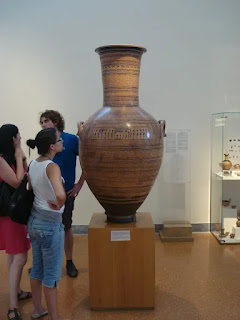The Dipylon Amphora from aproximately 700 BC is a masterpiece of art of ancient Greek pottery. Its expertly painted exterior shows a funeral scene with wasp-waisted human stylized figures along geometrical shapes and patterns.
Discovered in Keramikos, Athens at a gate called Dipylon at the entrance to an ancent cemetary there the maker of this gigantic piece along with the others who created ancient Greek masterpieces of pottery has always been assumed of being a male. Indeed the artisan here is referred to by historians as the Dipylon Amphora.but was the maker of this stricking grave marker and many other pieces of pottery was actually female? Sarah Murray. a classical archaelogist from the University of Toronto along with her undergraduate students are questioning long-held beliefs in this area. They believe that female participation in the making of artistic pottery is the work of women.
Unfortunately, there are no written records which date back to that era. Indeed pottery itself serves as a reminder of the hisorical events of those times in Greece.
"Pottery is the anchor of everything we say about society but I think that's problematic." Murray says in a new article in the American Journal of Archaeology.
"No one had really thought that women were involved in making this pottery but that is the truth," she added.

No comments:
Post a Comment